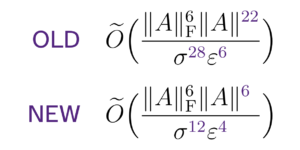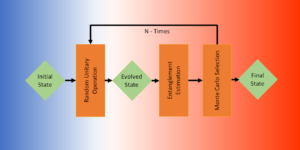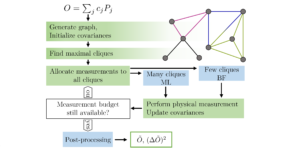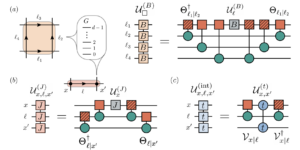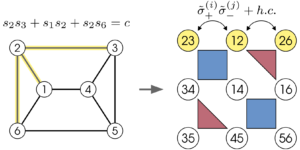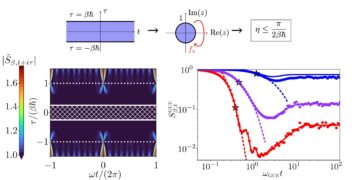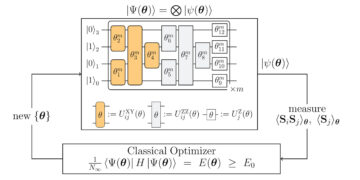Department of Electrical and Computer Engineering, Rice University, Houston, Texas 77005 USA
Department of Physics, California Institute of Technology, Pasadena, California 91125, USA
Institute for Quantum Information and Matter and Walter Burke Institute for Theoretical Physics, California Institute of Technology, Pasadena, California 91125, USA
Find this paper interesting or want to discuss? Scite or leave a comment on SciRate.
Abstract
Although tensor networks are powerful tools for simulating low-dimensional quantum physics, tensor network algorithms are very computationally costly in higher spatial dimensions. We introduce $textit{quantum gauge networks}$: a different kind of tensor network ansatz for which the computation cost of simulations does not explicitly increase for larger spatial dimensions. We take inspiration from the gauge picture of quantum dynamics, which consists of a local wavefunction for each patch of space, with neighboring patches related by unitary connections. A quantum gauge network (QGN) has a similar structure, except the Hilbert space dimensions of the local wavefunctions and connections are truncated. We describe how a QGN can be obtained from a generic wavefunction or matrix product state (MPS). All $2k$-point correlation functions of any wavefunction for $M$ many operators can be encoded exactly by a QGN with bond dimension $O(M^k)$. In comparison, for just $k=1$, an exponentially larger bond dimension of $2^{M/6}$ is generically required for an MPS of qubits. We provide a simple QGN algorithm for approximate simulations of quantum dynamics in any spatial dimension. The approximate dynamics can achieve exact energy conservation for time-independent Hamiltonians, and spatial symmetries can also be maintained exactly. We benchmark the algorithm by simulating the quantum quench of fermionic Hamiltonians in up to three spatial dimensions.
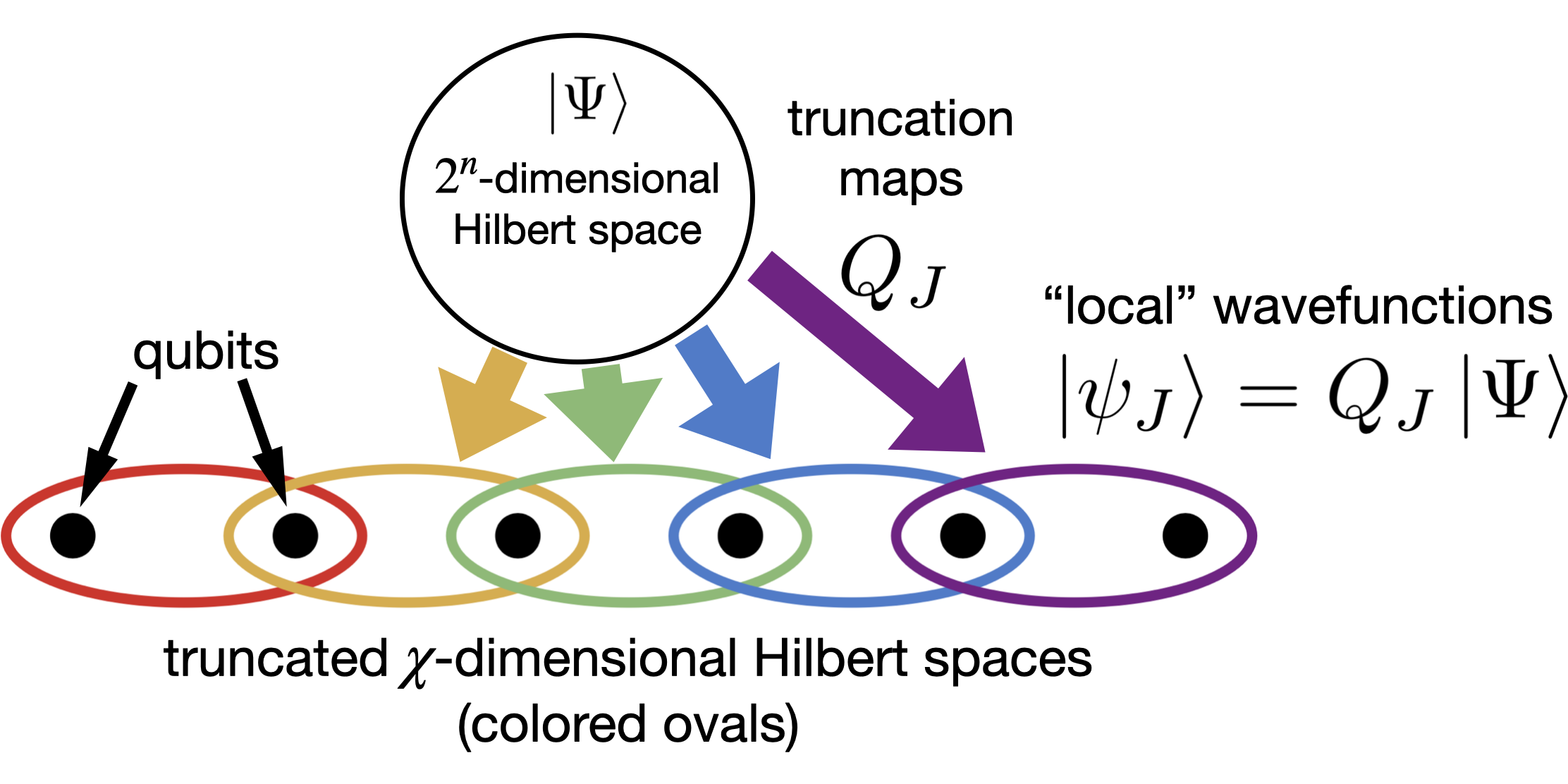
Featured image: In the gauge picture, different patches of space (ovals in figure) are associated with their own Hilbert spaces and wavefunctions, which are related by time-evolving unitary transformations. Each of these Hilbert spaces has the usual dimension of $2^n$ for a system of $n$ qubits. Quantum gauge networks take advantage of these multiple Hilbert spaces by efficiently truncating each Hilbert space into a smaller subspace of states that is most relevant for the local physics of the associated patch using a linear truncation map.
[embedded content]
Popular summary
Our work initiates the study of a novel wavefunction ansatz termed “quantum gauge network.” We show that quantum gauge networks are related to tensor networks in one spatial dimension, but are algorithmically simpler and potentially more efficient in two or more spatial dimensions. Quantum gauge networks make use of a new picture of quantum mechanics, called the “gauge picture,” which is briefly described in the featured image. We provide a simple algorithm to approximately simulate the time-evolution of a wavefunction using a quantum gauge network. We benchmark the algorithm on a system of fermions in up to three spatial dimensions. Simulating the three-dimensional system using tensor networks would be extremely challenging. However, further research is needed to better understand quantum gauge network theory and to develop more algorithms, such as a ground state optimization algorithm.
► BibTeX data
► References
[1] Kevin Slagle. “The Gauge Picture of Quantum Dynamics” (2022). arXiv:2210.09314.
arXiv:2210.09314
[2] Román Orús. “Tensor networks for complex quantum systems”. Nature Reviews Physics 1, 538–550 (2019). arXiv:1812.04011.
https://doi.org/10.1038/s42254-019-0086-7
arXiv:1812.04011
[3] Román Orús. “A practical introduction to tensor networks: Matrix product states and projected entangled pair states”. Annals of Physics 349, 117–158 (2014). arXiv:1306.2164.
https://doi.org/10.1016/j.aop.2014.06.013
arXiv:1306.2164
[4] Garnet Kin-Lic Chan, Anna Keselman, Naoki Nakatani, Zhendong Li, and Steven R. White. “Matrix Product Operators, Matrix Product States, and ab initio Density Matrix Renormalization Group algorithms” (2016). arXiv:1605.02611.
arXiv:1605.02611
[5] Ignacio Cirac, David Perez-Garcia, Norbert Schuch, and Frank Verstraete. “Matrix Product States and Projected Entangled Pair States: Concepts, Symmetries, and Theorems” (2020). arXiv:2011.12127.
https://doi.org/10.1103/RevModPhys.93.045003
arXiv:2011.12127
[6] Shi-Ju Ran, Emanuele Tirrito, Cheng Peng, Xi Chen, Luca Tagliacozzo, Gang Su, and Maciej Lewenstein. “Tensor network contractions” (2020). arXiv:1708.09213.
https://doi.org/10.1007/978-3-030-34489-4
arXiv:1708.09213
[7] Jacob C. Bridgeman and Christopher T. Chubb. “Hand-waving and interpretive dance: an introductory course on tensor networks”. Journal of Physics A Mathematical General 50, 223001 (2017). arXiv:1603.03039.
https://doi.org/10.1088/1751-8121/aa6dc3
arXiv:1603.03039
[8] Michael P. Zaletel and Frank Pollmann. “Isometric Tensor Network States in Two Dimensions”. Phys. Rev. Lett. 124, 037201 (2020). arXiv:1902.05100.
https://doi.org/10.1103/PhysRevLett.124.037201
arXiv:1902.05100
[9] Katharine Hyatt and E. M. Stoudenmire. “DMRG Approach to Optimizing Two-Dimensional Tensor Networks” (2019). arXiv:1908.08833.
arXiv:1908.08833
[10] Reza Haghshenas, Matthew J. O’Rourke, and Garnet Kin-Lic Chan. “Conversion of projected entangled pair states into a canonical form”. Phys. Rev. B 100, 054404 (2019). arXiv:1903.03843.
https://doi.org/10.1103/PhysRevB.100.054404
arXiv:1903.03843
[11] Maurits S. J. Tepaske and David J. Luitz. “Three-dimensional isometric tensor networks”. Physical Review Research 3, 023236 (2021). arXiv:2005.13592.
https://doi.org/10.1103/PhysRevResearch.3.023236
arXiv:2005.13592
[12] G. Vidal. “Class of Quantum Many-Body States That Can Be Efficiently Simulated”. Phys. Rev. Lett. 101, 110501 (2008). arXiv:quant-ph/0610099.
https://doi.org/10.1103/PhysRevLett.101.110501
arXiv:quant-ph/0610099
[13] G. Evenbly and G. Vidal. “Class of Highly Entangled Many-Body States that can be Efficiently Simulated”. Phys. Rev. Lett. 112, 240502 (2014). arXiv:1210.1895.
https://doi.org/10.1103/PhysRevLett.112.240502
arXiv:1210.1895
[14] G. Evenbly and G. Vidal. “Algorithms for entanglement renormalization”. Phys. Rev. B 79, 144108 (2009). arXiv:0707.1454.
https://doi.org/10.1103/PhysRevB.79.144108
arXiv:0707.1454
[15] Arturo Acuaviva, Visu Makam, Harold Nieuwboer, David Pérez-García, Friedrich Sittner, Michael Walter, and Freek Witteveen. “The minimal canonical form of a tensor network” (2022). arXiv:2209.14358.
arXiv:2209.14358
[16] Giovanni Ferrari, Giuseppe Magnifico, and Simone Montangero. “Adaptive-weighted tree tensor networks for disordered quantum many-body systems”. Phys. Rev. B 105, 214201 (2022). arXiv:2111.12398.
https://doi.org/10.1103/PhysRevB.105.214201
arXiv:2111.12398
[17] The time dynamics of a free fermion Hamiltonian $hat{H} = sum_{ij} h_{ij} hat{c}_i^dagger hat{c}_j$ can be simulated exactly by calculating the time-evolved filled single-fermion wavefunctions $|{phi_alpha(t)rangle} = e^{-iht} |{phi_alpha(0)rangle}$. The wavefunction $|{Psi}rangle = prod_alpha^text{filled} big(sum_i langle{i|phi_alpha}rangle hat{c}_i^daggerbig) |{0}rangle$ is never explicitly calculated. $prod_alpha^text{filled}$ denotes the product over the filled single-fermion wavefunctions, and $|{0}rangle$ is the empty state with no fermions. Then $langle{hat{n}_i(t)}rangle = sum_alpha^text{filled} |langle{i|phi_alpha(t)rangle}|^2$, where $|{i}rangle$ is the single-fermion wavefunction for a fermion at site $i$.
[18] Román Orús. “Advances on tensor network theory: symmetries, fermions, entanglement, and holography”. European Physical Journal B 87, 280 (2014). arXiv:1407.6552.
https://doi.org/10.1140/epjb/e2014-50502-9
arXiv:1407.6552
[19] Philippe Corboz and Guifré Vidal. “Fermionic multiscale entanglement renormalization ansatz”. Phys. Rev. B 80, 165129 (2009). arXiv:0907.3184.
https://doi.org/10.1103/PhysRevB.80.165129
arXiv:0907.3184
[20] Andrew M. Childs, Yuan Su, Minh C. Tran, Nathan Wiebe, and Shuchen Zhu. “Theory of trotter error with commutator scaling”. Phys. Rev. X 11, 011020 (2021). arXiv:1912.08854.
https://doi.org/10.1103/PhysRevX.11.011020
arXiv:1912.08854
[21] Bram Vanhecke, Laurens Vanderstraeten, and Frank Verstraete. “Symmetric cluster expansions with tensor networks” (2019). arXiv:1912.10512.
https://doi.org/10.1103/PhysRevA.103.L020402
arXiv:1912.10512
[22] Yi-Kai Liu. “Consistency of local density matrices is qma-complete”. In Josep Díaz, Klaus Jansen, José D. P. Rolim, and Uri Zwick, editors, Approximation, Randomization, and Combinatorial Optimization. Algorithms and Techniques. Pages 438–449. Berlin, Heidelberg (2006). Springer Berlin Heidelberg. arXiv:quant-ph/0604166.
arXiv:quant-ph/0604166
[23] Alexander A. Klyachko. “Quantum marginal problem and N-representability”. In Journal of Physics Conference Series. Volume 36 of Journal of Physics Conference Series, pages 72–86. (2006). arXiv:quant-ph/0511102.
https://doi.org/10.1088/1742-6596/36/1/014
arXiv:quant-ph/0511102
[24] Jianxin Chen, Zhengfeng Ji, Nengkun Yu, and Bei Zeng. “Detecting consistency of overlapping quantum marginals by separability”. Phys. Rev. A 93, 032105 (2016). arXiv:1509.06591.
https://doi.org/10.1103/PhysRevA.93.032105
arXiv:1509.06591
[25] David A. Mazziotti. “Structure of fermionic density matrices: Complete $n$-representability conditions”. Phys. Rev. Lett. 108, 263002 (2012). arXiv:1112.5866.
https://doi.org/10.1103/PhysRevLett.108.263002
arXiv:1112.5866
[26] Xiao-Gang Wen. “Colloquium: Zoo of quantum-topological phases of matter”. Reviews of Modern Physics 89, 041004 (2017). arXiv:1610.03911.
https://doi.org/10.1103/RevModPhys.89.041004
arXiv:1610.03911
[27] Zheng-Cheng Gu, Michael Levin, Brian Swingle, and Xiao-Gang Wen. “Tensor-product representations for string-net condensed states”. Phys. Rev. B 79, 085118 (2009). arXiv:0809.2821.
https://doi.org/10.1103/PhysRevB.79.085118
arXiv:0809.2821
[28] Oliver Buerschaper, Miguel Aguado, and Guifré Vidal. “Explicit tensor network representation for the ground states of string-net models”. Phys. Rev. B 79, 085119 (2009). arXiv:0809.2393.
https://doi.org/10.1103/PhysRevB.79.085119
arXiv:0809.2393
[29] Dominic J. Williamson, Nick Bultinck, and Frank Verstraete. “Symmetry-enriched topological order in tensor networks: Defects, gauging and anyon condensation” (2017). arXiv:1711.07982.
arXiv:1711.07982
[30] Tomohiro Soejima, Karthik Siva, Nick Bultinck, Shubhayu Chatterjee, Frank Pollmann, and Michael P. Zaletel. “Isometric tensor network representation of string-net liquids”. Phys. Rev. B 101, 085117 (2020). arXiv:1908.07545.
https://doi.org/10.1103/PhysRevB.101.085117
arXiv:1908.07545
[31] Guifré Vidal. “Efficient Simulation of One-Dimensional Quantum Many-Body Systems”. Phys. Rev. Lett. 93, 040502 (2004). arXiv:quant-ph/0310089.
https://doi.org/10.1103/PhysRevLett.93.040502
arXiv:quant-ph/0310089
[32] Sebastian Paeckel, Thomas Köhler, Andreas Swoboda, Salvatore R. Manmana, Ulrich Schollwöck, and Claudius Hubig. “Time-evolution methods for matrix-product states”. Annals of Physics 411, 167998 (2019). arXiv:1901.05824.
https://doi.org/10.1016/j.aop.2019.167998
arXiv:1901.05824
[33] Steven R. White and Adrian E. Feiguin. “Real-Time Evolution Using the Density Matrix Renormalization Group”. Phys. Rev. Lett. 93, 076401 (2004). arXiv:cond-mat/0403310.
https://doi.org/10.1103/PhysRevLett.93.076401
arXiv:cond-mat/0403310
[34] Jutho Haegeman, Christian Lubich, Ivan Oseledets, Bart Vandereycken, and Frank Verstraete. “Unifying time evolution and optimization with matrix product states”. Phys. Rev. B 94, 165116 (2016). arXiv:1408.5056.
https://doi.org/10.1103/PhysRevB.94.165116
arXiv:1408.5056
[35] Eyal Leviatan, Frank Pollmann, Jens H. Bardarson, David A. Huse, and Ehud Altman. “Quantum thermalization dynamics with Matrix-Product States” (2017). arXiv:1702.08894.
arXiv:1702.08894
[36] Christian B. Mendl. “Time evolution of matrix product operators with energy conservation” (2018). arXiv:1812.11876.
arXiv:1812.11876
[37] Piotr Czarnik, Jacek Dziarmaga, and Philippe Corboz. “Time evolution of an infinite projected entangled pair state: An efficient algorithm”. Phys. Rev. B 99, 035115 (2019). arXiv:1811.05497.
https://doi.org/10.1103/PhysRevB.99.035115
arXiv:1811.05497
[38] Daniel Bauernfeind and Markus Aichhorn. “Time dependent variational principle for tree Tensor Networks”. SciPost Physics 8, 024 (2020). arXiv:1908.03090.
https://doi.org/10.21468/SciPostPhys.8.2.024
arXiv:1908.03090
[39] Christopher David White, Michael Zaletel, Roger S. K. Mong, and Gil Refael. “Quantum dynamics of thermalizing systems”. Phys. Rev. B 97, 035127 (2018). arXiv:1707.01506.
https://doi.org/10.1103/PhysRevB.97.035127
arXiv:1707.01506
[40] Tibor Rakovszky, C. W. von Keyserlingk, and Frank Pollmann. “Dissipation-assisted operator evolution method for capturing hydrodynamic transport”. Phys. Rev. B 105, 075131 (2022). arXiv:2004.05177.
https://doi.org/10.1103/PhysRevB.105.075131
arXiv:2004.05177
[41] Mingru Yang and Steven R. White. “Time-dependent variational principle with ancillary Krylov subspace”. Phys. Rev. B 102, 094315 (2020). arXiv:2005.06104.
https://doi.org/10.1103/PhysRevB.102.094315
arXiv:2005.06104
[42] Benedikt Kloss, David Reichman, and Yevgeny Bar Lev. “Studying dynamics in two-dimensional quantum lattices using tree tensor network states”. SciPost Physics 9, 070 (2020). arXiv:2003.08944.
https://doi.org/10.21468/SciPostPhys.9.5.070
arXiv:2003.08944
[43] Álvaro M. Alhambra and J. Ignacio Cirac. “Locally Accurate Tensor Networks for Thermal States and Time Evolution”. PRX Quantum 2, 040331 (2021). arXiv:2106.00710.
https://doi.org/10.1103/PRXQuantum.2.040331
arXiv:2106.00710
[44] Sheng-Hsuan Lin, Michael Zaletel, and Frank Pollmann. “Efficient Simulation of Dynamics in Two-Dimensional Quantum Spin Systems with Isometric Tensor Networks” (2021). arXiv:2112.08394.
https://doi.org/10.1103/PhysRevB.106.245102
arXiv:2112.08394
[45] Markus Schmitt and Markus Heyl. “Quantum Many-Body Dynamics in Two Dimensions with Artificial Neural Networks”. Phys. Rev. Lett. 125, 100503 (2020). arXiv:1912.08828.
https://doi.org/10.1103/PhysRevLett.125.100503
arXiv:1912.08828
[46] Irene López Gutiérrez and Christian B. Mendl. “Real time evolution with neural-network quantum states”. Quantum 6, 627 (2022). arXiv:1912.08831.
https://doi.org/10.22331/q-2022-01-20-627
arXiv:1912.08831
[47] Sheng-Hsuan Lin and Frank Pollmann. “Scaling of Neural‑Network Quantum States for Time Evolution”. Physica Status Solidi B Basic Research 259, 2100172 (2022). arXiv:2104.10696.
https://doi.org/10.1002/pssb.202100172
arXiv:2104.10696
[48] Dariia Yehorova and Joshua S. Kretchmer. “A multi-fragment real-time extension of projected density matrix embedding theory: Non-equilibrium electron dynamics in extended systems” (2022). arXiv:2209.06368.
https://doi.org/10.1063/5.0146973
arXiv:2209.06368
[49] G. Münster and M. Walzl. “Lattice Gauge Theory – A short Primer” (2000). arXiv:hep-lat/0012005.
arXiv:hep-lat/0012005
[50] John B. Kogut. “An introduction to lattice gauge theory and spin systems”. Rev. Mod. Phys. 51, 659–713 (1979).
https://doi.org/10.1103/RevModPhys.51.659
[51] Kevin Slagle and John Preskill. “Emergent Quantum Mechanics at the Boundary of a Local Classical Lattice Model” (2022). arXiv:2207.09465.
https://doi.org/10.1103/PhysRevA.108.012217
arXiv:2207.09465
[52] Scott Aaronson. “Multilinear formulas and skepticism of quantum computing”. In Proceedings of the Thirty-Sixth Annual ACM Symposium on Theory of Computing. Page 118–127. STOC ’04New York, NY, USA (2004). Association for Computing Machinery. arXiv:quant-ph/0311039.
https://doi.org/10.1145/1007352.1007378
arXiv:quant-ph/0311039
[53] Gerard ‘t Hooft. “Deterministic Quantum Mechanics: the Mathematical Equations” (2020). arXiv:2005.06374.
arXiv:2005.06374
[54] Stephen L Adler. “Quantum theory as an emergent phenomenon: Foundations and phenomenology”. Journal of Physics: Conference Series 361, 012002 (2012).
https://doi.org/10.1088/1742-6596/361/1/012002
[55] Vitaly Vanchurin. “Entropic Mechanics: Towards a Stochastic Description of Quantum Mechanics”. Foundations of Physics 50, 40–53 (2019). arXiv:1901.07369.
https://doi.org/10.1007/s10701-019-00315-6
arXiv:1901.07369
[56] Edward Nelson. “Review of stochastic mechanics”. Journal of Physics: Conference Series 361, 012011 (2012).
https://doi.org/10.1088/1742-6596/361/1/012011
[57] Michael J. W. Hall, Dirk-André Deckert, and Howard M. Wiseman. “Quantum Phenomena Modeled by Interactions between Many Classical Worlds”. Physical Review X 4, 041013 (2014). arXiv:1402.6144.
https://doi.org/10.1103/PhysRevX.4.041013
arXiv:1402.6144
[58] Guifré Vidal. “Efficient Classical Simulation of Slightly Entangled Quantum Computations”. Phys. Rev. Lett. 91, 147902 (2003). arXiv:quant-ph/0301063.
https://doi.org/10.1103/PhysRevLett.91.147902
arXiv:quant-ph/0301063
[59] G. Vidal. “Classical Simulation of Infinite-Size Quantum Lattice Systems in One Spatial Dimension”. Phys. Rev. Lett. 98, 070201 (2007). arXiv:cond-mat/0605597.
https://doi.org/10.1103/PhysRevLett.98.070201
arXiv:cond-mat/0605597
[60] Stephan Ramon Garcia, Matthew Okubo Patterson, and William T. Ross. “Partially isometric matrices: a brief and selective survey” (2019). arXiv:1903.11648.
arXiv:1903.11648
[61] C. J. Hamer. “Finite-size scaling in the transverse Ising model on a square lattice”. Journal of Physics A Mathematical General 33, 6683–6698 (2000). arXiv:cond-mat/0007063.
https://doi.org/10.1088/0305-4470/33/38/303
arXiv:cond-mat/0007063
Cited by
[1] Sayak Guha Roy and Kevin Slagle, “Interpolating Between the Gauge and Schrödinger Pictures of Quantum Dynamics”, arXiv:2307.02369, (2023).
[2] Kevin Slagle, “The Gauge Picture of Quantum Dynamics”, arXiv:2210.09314, (2022).
The above citations are from SAO/NASA ADS (last updated successfully 2023-09-15 05:31:41). The list may be incomplete as not all publishers provide suitable and complete citation data.
On Crossref’s cited-by service no data on citing works was found (last attempt 2023-09-15 05:31:39).
This Paper is published in Quantum under the Creative Commons Attribution 4.0 International (CC BY 4.0) license. Copyright remains with the original copyright holders such as the authors or their institutions.
- SEO Powered Content & PR Distribution. Get Amplified Today.
- PlatoData.Network Vertical Generative Ai. Empower Yourself. Access Here.
- PlatoAiStream. Web3 Intelligence. Knowledge Amplified. Access Here.
- PlatoESG. Automotive / EVs, Carbon, CleanTech, Energy, Environment, Solar, Waste Management. Access Here.
- PlatoHealth. Biotech and Clinical Trials Intelligence. Access Here.
- ChartPrime. Elevate your Trading Game with ChartPrime. Access Here.
- BlockOffsets. Modernizing Environmental Offset Ownership. Access Here.
- Source: https://quantum-journal.org/papers/q-2023-09-14-1113/
- :has
- :is
- :not
- :where
- ][p
- $UP
- 06
- 1
- 10
- 100
- 11
- 12
- 125
- 13
- 14
- 15%
- 16
- 17
- 19
- 20
- 2000
- 2005
- 2006
- 2008
- 2011
- 2012
- 2014
- 2016
- 2017
- 2018
- 2019
- 2020
- 2021
- 2022
- 2023
- 22
- 23
- 24
- 25
- 26%
- 27
- 28
- 29
- 30
- 31
- 32
- 33
- 36
- 361
- 39
- 40
- 41
- 49
- 50
- 51
- 54
- 60
- 7
- 8
- 80
- 87
- 9
- 91
- 97
- 98
- a
- above
- ABSTRACT
- access
- accurate
- Achieve
- ACM
- adrian
- ADvantage
- affiliations
- Alexander
- algorithm
- algorithmically
- algorithms
- All
- also
- an
- and
- Andrew
- annual
- any
- approach
- approximate
- approximately
- ARE
- artificial
- AS
- associated
- Association
- At
- author
- authors
- bar
- basic
- BE
- Benchmark
- Berlin
- Better
- between
- bond
- boundary
- Break
- Brian
- briefly
- but
- by
- calculated
- calculating
- california
- called
- CAN
- Capturing
- challenging
- chan
- chen
- Cheng
- Christopher
- Chubb
- class
- Cluster
- comment
- Commons
- comparison
- complete
- complex
- complicated
- computation
- computations
- computer
- Computer Engineering
- computing
- concepts
- conditions
- Conference
- Connections
- CONSERVATION
- consists
- content
- contraction
- copyright
- Correlation
- Cost
- costly
- Course
- dance
- Daniel
- data
- David
- demanding
- demonstrated
- denotes
- dependent
- describe
- described
- description
- develop
- different
- Dimension
- dimensions
- discuss
- does
- due
- dynamics
- e
- each
- Edward
- efficient
- efficiently
- embedded
- embedding
- energy
- Engineering
- enormous
- entanglement
- equations
- error
- European
- evolution
- exactly
- Except
- exponential
- Exponential Growth
- exponentially
- extension
- extremely
- featured
- Ferrari
- Figure
- filled
- For
- form
- found
- Foundations
- frank
- Free
- from
- functions
- further
- Gang
- gauge
- General
- gerard
- Grid
- Ground
- Group
- Growth
- Hall
- harold
- harvard
- Have
- higher
- highly
- holders
- holography
- houston
- How
- However
- HTTPS
- image
- in
- Increase
- Infinite
- information
- Initiates
- Inspiration
- Institute
- institutions
- interactions
- interesting
- International
- into
- introduce
- Introduction
- introductory
- ivan
- JavaScript
- John
- joshua
- journal
- just
- Kind
- klaus
- known
- larger
- Last
- Leave
- less
- Li
- License
- lin
- List
- local
- machinery
- make
- many
- map
- March
- mathematical
- Matrix
- Matter
- matthew
- max-width
- May..
- mechanics
- meeting
- method
- methods
- Michael
- minimal
- model
- models
- Modern
- Month
- more
- more efficient
- most
- multiple
- Nature
- needed
- neighboring
- network
- networks
- neural
- neural networks
- never
- New
- nick
- no
- notable
- novel
- number
- NY
- obtained
- of
- on
- ONE
- open
- operator
- operators
- optimization
- optimizing
- or
- order
- original
- over
- own
- page
- pages
- pair
- Paper
- Patch
- Patches
- Phases of Matter
- phenomenon
- Philippe
- physical
- Physics
- picture
- Pictures
- plato
- Plato Data Intelligence
- PlatoData
- potentially
- powerful
- Practical
- principle
- Problem
- Proceedings
- Product
- projected
- provide
- published
- publisher
- publishers
- Quantum
- quantum computing
- quantum information
- Quantum Mechanics
- quantum physics
- quantum systems
- qubits
- R
- ramon
- real-time
- references
- related
- relevant
- remains
- representation
- required
- research
- review
- Reviews
- Rice
- roy
- s
- scaling
- scott
- scott aaronson
- selective
- Series
- Short
- show
- similar
- Simple
- simpler
- simulation
- site
- Skepticism
- smaller
- Space
- spaces
- Spatial
- Spin
- square
- State
- States
- Status
- Stephen
- steven
- structure
- Study
- success
- Successfully
- such
- suitable
- Survey
- Symposium
- system
- Systems
- Take
- techniques
- Technology
- texas
- that
- The
- their
- then
- theoretical
- theory
- thermal
- These
- they
- this
- three
- three-dimensional
- time
- Title
- to
- tools
- towards
- transformations
- transport
- tree
- truncation
- two
- under
- understand
- university
- updated
- URL
- USA
- use
- using
- very
- via
- volume
- von
- W
- want
- was
- we
- which
- while
- white
- william
- with
- Work
- works
- world’s
- would
- X
- xi
- year
- york
- youtube
- Yuan
- zephyrnet
- ZOO





